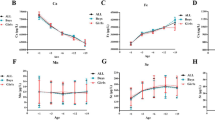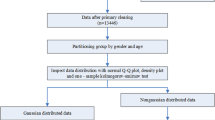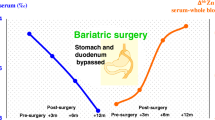Abstract
Patients having inborn errors of intermediary metabolism (IEMs) may have element deficiencies related to dietary treatment. Our objective was to study several elements [cobalt (Co), copper (Cu), zinc (Zn), selenium (Se), manganese (Mn), molybdenum (Mo) and magnesium (Mg)] in patients with IEMs with and without dietary treatment and to compare these results with those established in a healthy paediatric population. We studied 72 patients with IEMs (age range 2 months–44 years; median 10.5 years), with and without protein-restricted dietary treatment. Control values were established in 92 subjects (age range 1 day–42 years; median 6.5 years). Dietary treatment consisted of a natural protein-restricted diet supplemented with a special formula, depending on the specific metabolic defect. Samples were analysed with an Agilent 7500ce-ICP mass spectrometer. Significant differences were observed when we compared patients under dietary treatment and control values for Se and Co (P < 0.0001). No differences were observed for the other elements when the different groups were compared, except for Co (IEM patients without dietary treatment vs control group; P = 0.003). For Se and cobalamin, the daily intake of our patients (Se 48 ± 16 µg/day; cobalamin 3.5 µg/day) was slightly higher than the recommended daily averages (RDAs) (40 µg/day and 1.8 µg/day, respectively). We concluded that IEM patients under dietary treatment showed significantly lower selenium values in spite of correct supplementation, reinforcing the idea that these patients should be regularly monitored, at least for this element. Further investigations seem advisable about Se and Co availability in special diets.

Similar content being viewed by others
Abbreviations
- PKU:
-
phenylketonuria
- IEM:
-
inborn error of metabolism
- ICP-MS:
-
inductively coupled plasma mass spectrometry
- RDA:
-
recommended daily averages
References
Acosta PB (1996) Nutrition studies in treated infants and children with phenylketonuria: vitamins, minerals, trace elements. Eur J Pediatr 155:136–139
Acosta PB, Yannicelli S (1999) Plasma micronutrient concentrations in infants undergoing therapy for phenylketonuria. Biol Trace Elem Res 67:75–84
Barretto JR, Silva LR, Leite ME et al (2008) Poor zinc and selenium status in phenylketonuric children and adolescents in Brazil. Nutr Res 28:208–211
Barschak AG, Sitta A, Deon M et al (2007) Erythrocyte glutathione peroxidase activity and plasma selenium concentration are reduced in maple syrup urine disease patients during treatment. Int J Dev Neurosci 25:335–338
Bocca B, Forte G, Petrucci F et al (2005) Development of methods for the quantification of essential and toxic elements in human biomonitoring. Ann Ist Super Sanita 41:165–170
Brenton DP, Pietz J (2000) Adult care in phenylketonuria and hyperphenylalaninaemia: the relevance of neurological abnormalities. Eur J Pediatr 159:S114–S120
Darling G, Mathias P, O’Regan M et al (1992) Serum selenium levels in individuals on PKU diets. J Inherit Metab Dis 15:769–773
Fisberg RM, Da Silva-Femandes ME, Fisberg M et al (1999) Plasma zinc, copper, and erythrocyte superoxide dismutase in children with phenylketonuria. Nutrition 15:449–452
Food and Nutrition Board, Institute of Medicine, National Academies: Dietary Reference Intakes (DRIs): Recommended intakes for individuals. 2004. Internet: http://www.iom.edu/Object.File/Master/21/372/0.pdf
Gassió R, Artuch R, Vilaseca MA et al (2008) Cognitive functions and the antioxidant system in phenylketonuric patients. Neuropsychology 22:426–431
Heitland P, Köster HD (2006) Biomonitoring of 37 trace elements in blood samples from inhabitants of northern Germany by ICP-MS. J Trace Elem Med Biol 20:253–262
Herrero E, Coperías JL, Serrano E (1998) Cobalto. In: Cocho JA, Escanero JF, de Buitrago JM González (eds) Elementos traza: aspectos bioquímicos, analíticos y clínicos. Sociedad Española de Bioquímica Clínica y Patología Molecular (SEQC), Barcelona, pp 195–206
Hsiung CS, Andrade JD, Costa R et al (1997) Minimizing interferences in the quantitative multielement analysis of trace elements in biological fluids by inductively coupled plasma mass spectrometry. Clin Chem 43:2303–2311
Kobayashi M, Shimizu S (1999) Cobalt proteins. Eur J Biochem 261:1–9
Lombeck I, Ebert KH, Kasperek K et al (1984) Selenium intake of infants and young children, healthy children and dietetically treated patients with phenylketonuria. Eur J Pediatr 143:99–102
Mahalingam TR, Vijayalakshmi S, Prabhu RK et al (1997) Studies on some trace and minor elements in blood. A survey of the Kalpakkam (India) population. Part III: Studies on dietary intake and its correlation to blood levels. Biol Trace Elem Res 57:223–238.
Saudubray JM (1995) The metabolic and molecular bases of inherited disease. In: Scriver CR, Beaudet AL, Sly WS, Valle D (eds) Clinical phenotypes: diagnosis/algorithms, 7th edn. McGraw-Hill, New York, pp 327–400
Sierra C, Vilaseca MA, Moyano D et al (1998) Antioxidant status in hyperphenylalaninemia. Clin Chim Acta 276:1–9.
Van Bakel MM, Printzem G, Wermuth B et al (2000) Antioxidant and thyroid hormone status in selenium-deficient phenylketonuric and hyperphenylalaninemic patients. Am J Clin Nutr 72:976–981
Van Dael P, Davidson L, Muñoz-Box R, Fay LB, Barclay D (2001) Selenium absorption and retention from a selenite- or selenate-fortified milk-based formula in men measured by a stable-isotope technique. Br J Nutr 85:157–163
Wahlen R, Evans L, Turner J, et al (2005) The use of collision/reaction cell ICP-MS for the simultaneous determination of 18 elements in blood and serum samples. Agilent Technologies. http://www.agilent.com/chem
Wilke BC, Vidailhet M, Favier A, et al (1992) Selenium glutathione peroxidise (GSH-Px) and lipid peroxidation products before and after selenium supplementation. Clin Chim Acta 207:137–142
Yannicelli S, Hambidge KM, Picciano MF (1992) Decreased selenium intake and low plasma selenium concentrations leading to clinical symptoms in a child with propionic acidaemia. J Inherit Metab Dis 15:261–268
Acknowledgements
We are very grateful to A. Fernández, R.M. Puig and M. Quintana for their skilful technical assistance. The Centre for Biomedical Research on Rare Diseases (CIBERER) is an initiative of the Instituto de Salud Carlos III (ISCIII), Spain. ICP-MS was funded by ISCIII, Ministerio de ciencia e innovación (MICINN), Spain. R. Artuch was supported by the programa de intensificación investigadora (ISCIII).
Author information
Authors and Affiliations
Corresponding author
Additional information
Communicated by: Marinus Duran
Rights and permissions
About this article
Cite this article
Tondo, M., Lambruschini, N., Gomez-Lopez, L. et al. The monitoring of trace elements in blood samples from patients with inborn errors of metabolism. J Inherit Metab Dis 33 (Suppl 3), 43–49 (2010). https://doi.org/10.1007/s10545-009-9015-8
Received:
Revised:
Accepted:
Published:
Issue Date:
DOI: https://doi.org/10.1007/s10545-009-9015-8




